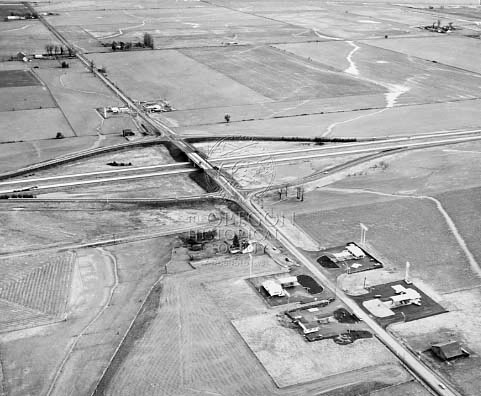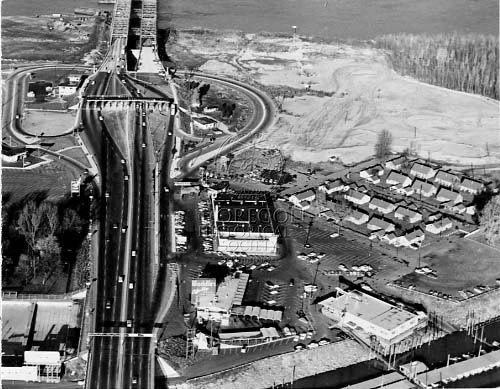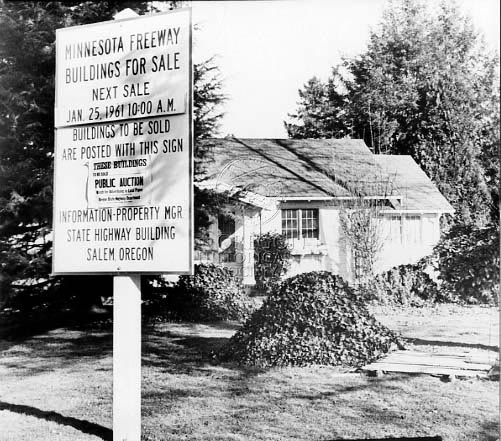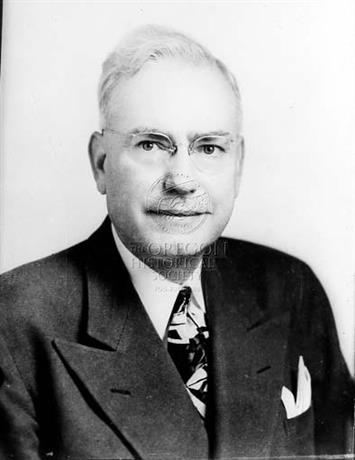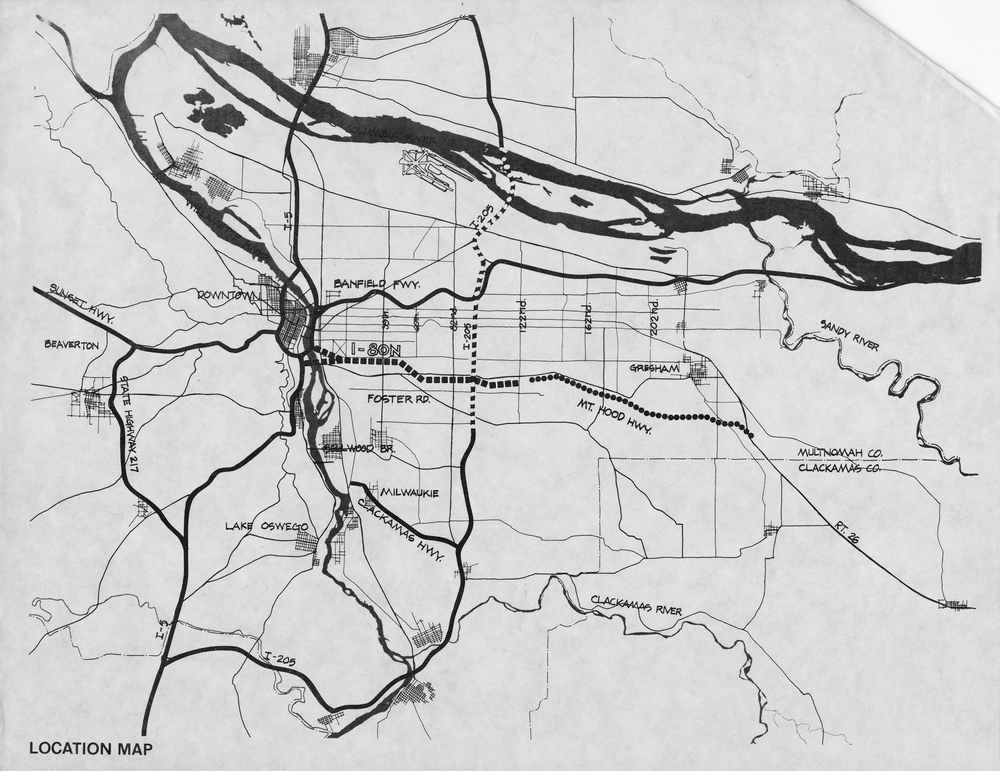Interstate 5 is a 308-mile-long segment of highway that runs between the California state line and the Columbia River. The highway is a major element in Oregon’s 731-mile portion of the 41,000-mile, federally funded Interstate and Defense Highway Program, established by the Federal-Aid Highway Act. Construction of I-5 in Oregon was completed in 1966.
Oregon had long been a leader in road construction, and the state’s response to the 1956 act was complicated by work the state had already undertaken to improve its roads. Even before World War II, Oregon’s roads—particularly U.S. 99, known as the Pacific Highway—were in poor condition, and Oregon State Highway Department (OSHD) planners urged major upgrades to the system.
In 1949, Oregon raised its gas tax to develop funds for road improvement, and between 1951 and 1953 the state authorized more than $70 million in highway bonds. In the 1952-1954 Biennial Report, State Highway Engineer R.H. Baldock reported plans to build a “New Pacific Highway.” The new road would generally follow U.S. 99 but would be built on an “entirely new alignment, and entirely new pavement, all to be built to expressway standards.”
Oregon’s early highways were typical of pre-interstate development, with crossroads, stoplights, and roadside businesses. “Expressways” were envisioned as “limited access highways” that would create faster, safer routes unimpeded by visual clutter and potential hazards.
A major focus of post-World War II transportation design was the twin ideas of grade separation and controlled access. On the interstate, drivers would enter and exit at designated points to ensure smooth transitions into traffic. On-ramps and off-ramps entered the language, and interstates became a new focal point for commercial development. Grade separation—that is, sending cross streets over or under the highway—reduced accidents and allowed traffic to flow uninterrupted at uniform speed. These concepts played a major role in Oregon’s traffic planning after 1947, when the Oregon legislature gave OSHD the authority to build grade-separated and controlled-access routes.
By 1953, Oregon was actively building limited access and grade-separated highways, most of which bypassed existing routes. These new highways included the Portland-Salem Expressway (later called the Baldock Freeway) and the Banfield Freeway, east of downtown Portland. As a result, Oregon was well underway with major highway improvements by 1956, when Congress authorized the federal government to underwrite 90 percent of the costs associated with a system of highways to connect the nation. Oregon was the first state west of the Mississippi River to complete its work.
To make the construction process manageable, OSHD divided the interstate in Oregon into segments—lengths of road that were contracted, built, and opened independently—to allow progress despite difficulties associated with certain portions. Sometimes those issues were political, not technical, as siting decisions could be highly controversial. This was especially true for the so-called Minnesota or East Bank Freeway, which would avoid affecting valuable properties downtown by dividing the established neighborhoods of North Portland, the heart of the city’s African American community.
Other segments, particularly the elevated viaduct through Medford, were the somewhat imperfect result of compromise. The route through the Siskiyou Mountains, still the steepest grade anywhere on Interstate 5, cost more per mile than any other portion and was so difficult to build that the completion date was delayed. That route was the result of pressure from southern Oregon interests who wanted the new interstate to run parallel to U.S. 99, through the Rogue Valley, rather than parallel to U.S. 97 through central Oregon. Later connecting routes, including I-105, I-205, and I-405 in the Portland and Eugene areas, were also funded by the interstate program.
In October 1966, the final link in I-5—the dual-decked Marquam Bridge, which carried the highway over the Willamette River in downtown Portland—was completed. Four days later, at the Cow Creek Safety Rest Area south of Canyonville, Governor Mark O. Hatfield presided over a ceremony to formally dedicate Oregon’s completion of the highway. On that rainy Saturday, amid other speeches, Eugene Bauer, the mayor of Gladstone and president of the League of Oregon Cities, called Interstate 5 “one of the greatest of economic arteries.”
-
![]()
I-5 Freeway interchange with Corvallis/Lebanon Highway, HWY 20.
Oregon Historical Society Research Library, 020501
-
![]()
Aerial view of toll booths on Interstate Bridge approaches, 1959.
Oregon Historical Society Research Library, 021803
-
![]()
Sign informing of next public auction of buildings in the path of I-5, 1961.
Oregon Historical Society Research Library, Oregon Journal Collection, 001547
-
![]()
Robert Baldock, Chief Engineer of Oregon State Highway Commission, 1946. I-5 Portland to Salem is named after him.
Oregon Historical Society Research Library, Oregon Journal Collection, 000042
-
![]()
Interstate Bridge, June 1958.
Oregon Historical Society Research Library, Digital Collections, Al Monner news negatives; Org. Lot 1284; Box 63; 3118-1
Related Entries
-
Columbia River Highway
The Columbia River Highway, now known as the Historic Columbia River Hi…
-
Mount Hood Freeway
The Mount Hood Freeway, if constructed, would have passed through south…
-
![US 101 (Oregon Coast Highway)]()
US 101 (Oregon Coast Highway)
Many places on the Oregon coast were virtually inaccessible in the earl…
Related Historical Records
Map This on the Oregon History WayFinder
The Oregon History Wayfinder is an interactive map that identifies significant places, people, and events in Oregon history.
Further Reading
Kramer, George. The Interstate Highway System in Oregon: A Historic Overview. Eugene, Ore.: Heritage Research Associates, Inc., May 2004.
Oregon State Highway Commission. 20th Biennial Report of the Oregon State Highway Commission. Salem, Ore.: Oregon State Printing Department, 1952.

